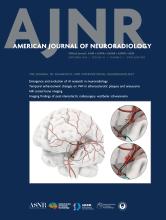This article requires a subscription to view the full text. If you have a subscription you may use the login form below to view the article. Access to this article can also be purchased.
Abstract
BACKGROUND AND PURPOSE: Material-specific reconstructions of dual-energy CTA (DECTA) can highlight iodinated contrast, subtract predefined materials, and reduce metal artifact. We present a technique to improve detection of residual aneurysms after endovascular coiling by which iodine-map DECTA (IM-DECTA) reconstructions subtract platinum coil artifacts in MIP images (MIP IM-DECTA) and assess if IM-DECTA offers improved detection over conventional CTA (CCTA) or monoenergetic DECTA.
MATERIALS AND METHODS: We included consecutive patients who underwent endovascular aneurysm coiling with follow-up DECTA and DSA within 24 months. DECTA was performed at 80- and 150-kVp tube voltages on a rapid kV-switching single-source Revolution scanner. CCTA and IM-DECTA series were reconstructed. Reference-standard DSA was compared with CCTA, 50- and 70-keV virtual monochromatic DECTA, IM-DECTA, and MIP IM-DECTA. Blinded to DSA data, cross-section images were reviewed in consensus by 3 neurointerventionalists for residual aneurysms and assigned modified Raymond-Roy classifications (mRRC). Sensitivity, specificity, and accuracy of each series is reported relative to DSA, and single-factor ANOVA and pair-wise Spearman correlation coefficients compared the accuracy of each series. Readers provided ROI measurements of HU deviation adjacent to the aneurysm neck for quantitative noise assessment and qualitatively scored each series on a 3-point Likert-style scale ranging from uninterpretable to excellent image quality.
RESULTS: Twenty-one patients with 25 coiled aneurysms were included. Mean time from DECTA to DSA was 286 ± 212 days. IM-DECTA and MIP IM-DECTA most sensitively (89% and 90%) and specifically (93% and 93%) detected residual aneurysms relative to CCTA (6% and 86%). Relative to DSA, IM-DECTA and MIP IM-DECTA most accurately detected (92% versus 28% for CCTA) and classified residual aneurysms by mRRC (ρC-CTA = −0.08; ρIM = 0.50; ρIM-MIP = 0.55; P < .001). Reader consensus reported the best image quality at the aneurysm neck with IM-DECTA and MIP IM-DECTA, with 56% of CCTAs considered uninterpretable versus 0% of IM-DECTAs, and image noise was significantly lower for IM-DECTA (27.9 ± 3.6 HU) or MIP IM-DECTA (26.8 ± 3.5 HU) than CCTA (103.2 ± 13.3 HU; P < .001).
CONCLUSIONS: MIP IM-DECTA can subtract coil mass artifact and is more sensitive and specific than CCTA for the detection of residual aneurysms after endovascular coiling.
ABBREVIATIONS:
- CCTA
- conventional CTA
- DECT
- dual-energy CT
- DECTA
- dual-energy CTA
- IM
- iodine map
- mRRC
- modified Raymond-Roy classification
- © 2024 by American Journal of Neuroradiology












